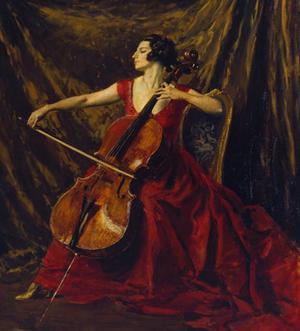Guilhermina Suggia facts for kids

Guilhermina Suggia (born June 27, 1885, died July 30, 1950) was a famous cellist from Portugal. She became known around the world for her amazing talent. She studied music in Paris, France, with the well-known cellist Pablo Casals. Guilhermina Suggia lived in the United Kingdom for many years, where people greatly admired her music. She stopped performing in 1939 but came back to play concerts in Britain during World War II. Her very last concert was in 1949, a year before she passed away.
Guilhermina Suggia left money to create an important scholarship in Britain for young cellists. This scholarship has helped many talented musicians, including Jacqueline du Pré and Steven Isserlis, to continue their studies and become great performers.
Contents
About Guilhermina Suggia
Early Life and Music Training
Guilhermina Suggia was born in Porto, Portugal. Her family had roots in both Portugal and Italy. Her father was a skilled musician and taught her about music theory and how to play the cello. She learned very quickly! By the time she was just 12 years old, she became the main cellist for her local orchestra, the Orpheon Portuense.
In 1904, Queen Maria Amélia of Portugal helped Suggia go to Leipzig, Germany, to study. There, she took private lessons from a famous teacher named Julius Klengel.
Becoming a World-Famous Cellist
Within a year of studying in Leipzig, Suggia was asked to play as a solo artist with the Leipzig Gewandhaus Orchestra. This was a very big honor! From 1906 to 1912, she lived and worked in Paris with another famous cellist, Pablo Casals. They were both considered among the best cellists in the world.
Guilhermina Suggia began to travel and perform internationally, which helped her become even more famous. In 1914, she formed a music group with violinist Jelly d'Arányi and pianist Fanny Davies. During the 1920s and 1930s, when she lived in Britain, she often visited Lindisfarne Castle in northern England. Today, a cello rests in the Music Room there to remember her visits. Her own special "Montagnana" cello is now kept in the Conservatório de Música do Porto, in her hometown in Portugal.
Later Years and Legacy
In 1927, Guilhermina Suggia married Jose Mena, who was a specialist in X-rays. During World War II, she and her husband moved back to Portugal. After the war, she returned to Britain to play concerts. She performed the Elgar Cello Concerto to help raise money for charity. Her last concerts were at the Edinburgh International Festival in 1949 and in Bournemouth later that same year.
Guilhermina Suggia passed away from cancer in Porto when she was 65 years old. This was a year after her husband died.
Recordings and Music
Guilhermina Suggia made a few recordings of her cello playing. These included pieces by Joseph Haydn and Camille Saint-Saëns. These recordings were later put onto CDs so more people could hear her beautiful music.
Suggia's Lasting Impact
The Suggia Scholarship
Guilhermina Suggia left her valuable Stradivarius cello to the Royal Academy of Music in London. She wanted it to be sold to create a scholarship for young cellists. This scholarship, called the Suggia Gift, started in 1955. It has helped many talented cellists, including Rohan de Saram, Jacqueline du Pré, Robert Cohen, Steven Isserlis, and Julian Lloyd Webber.
Honoring Her Memory
Many places and things have been named after Guilhermina Suggia to honor her. The large concert hall at Casa da Música in Porto, her hometown, is called Sala Suggia. Even an airplane belonging to TAP Portugal, the national airline, was named after her! It was an Airbus A319.
Famous Portrait
One of the most famous images of Guilhermina Suggia is a large oil painting by the Welsh artist Augustus John. He started painting it in 1920 and finished it in 1923. This painting is now kept at the Tate Gallery in London. It shows her playing the cello with great nobility. A newspaper called The Manchester Guardian wrote that the painting would remind people for years to come how noble her art and her presence on stage were. Other photographs of Suggia are also kept in important museums, like the George Eastman Museum and the National Portrait Gallery, London.
See also
 In Spanish: Guilhermina Suggia para niños
In Spanish: Guilhermina Suggia para niños

